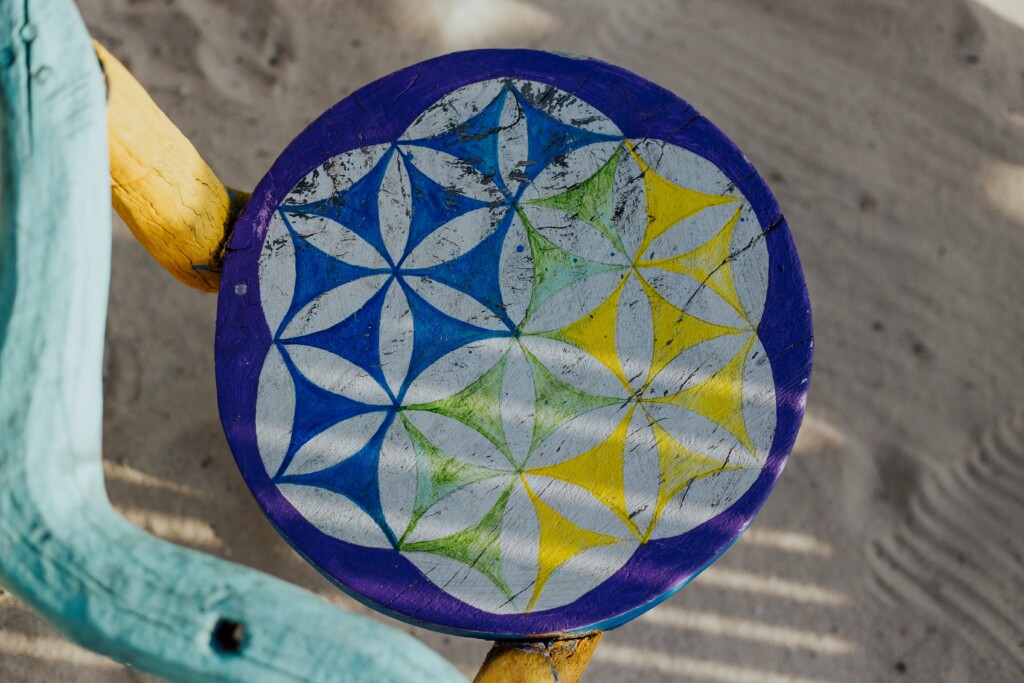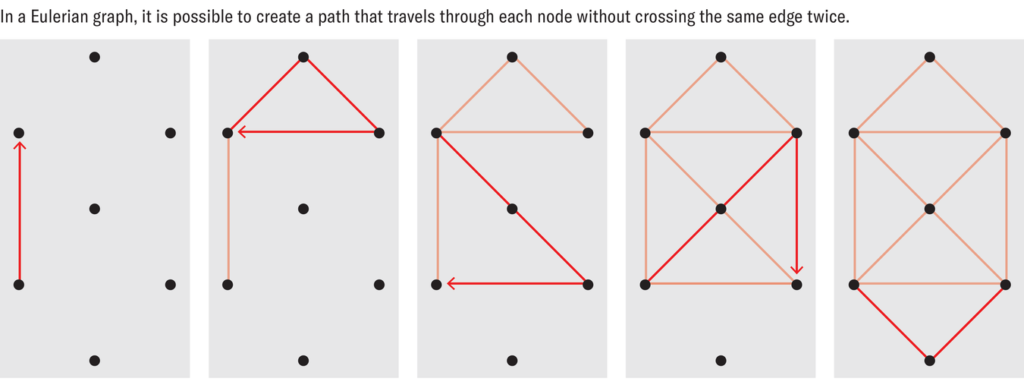[해외 DS] 샌드아트와 수학의 만남, 일시적인 예술의 영원한 이야기 (2)
초보자부터 전문가까지 모두가 일련의 규칙을 따르지만, 문서로 기록하지 않아 규칙은 정점·간선·차수·움직임에 대한 제한 등을 포함, '오일러 그래프' 정리와 대응 전체 그림을 구성하는 각 하위 단계도 시작점과 끝점이 동일해, 오묘한 재귀적 성질
[해외DS] 샌드아트와 수학의 만남, 일시적인 예술의 영원한 이야기 (1)에서 이어집니다.

모래 그림에는 다양한 전문 지식과 수준이 존재한다. 어떤 이들은 모래 그림을 전혀 연습하지 않거나, 몇 개의 간단한 그림만 그릴 줄 아는 사람이 있는 반면, 바누아투 사회에서 지정한 ‘전문가’들은 풍부한 레퍼토리를 가진다고 알려져 있다(일부에 따르면 최대 400개의 그림을 그릴 수 있다고 한다). 초기의 모래 그림은 남성의 전유물이라고 여겨졌지만, 오늘날에는 그렇지 않다. 몇몇 여성들도 뛰어난 전문성을 보유하고 있다.
또한 초보자부터 전문가까지 모두가 일련의 규칙을 따르는데, 문서로 기록된 것은 없다. 전통적인 지식이 구전으로 전해지며 대부분은 일관성 있는 원칙을 따른다. 모든 도면은 일련의 노드 또는 교차점, 선을 정의하는 그리드로 시작된다. 규칙은 움직임을 제한하기도 한다. 아티스트는 (1) 노드에서 노드로 이동할 때 같은 경로를 가로지르거나 노드 이외의 그리드를 자르지 않고 (2) 손가락을 떼지 않고 시작 지점으로 돌아와야 한다는 것이다. 현장에서 발견한 또 다른 규칙이 있었는데, 이 규칙은 실바의 모델에서 매우 중요한 역할을 한다고 밝혀졌다. 이에 대한 설명은 아래에서 찾아볼 수 있다.
민족수학 선구자들의 혜안, 문자 없는 사회의 수학적 지식 발견
샌드 아트의 규칙이 수학의 개념과 유사하다는 것을 알아차린 사람은 실바가 처음이 아니다. 그의 논문은 민족수학의 선구자인 미국 수학자 마르시아 애셔(Marcia Ascher)가 1980년대에 수행한 연구의 연장선상에 있다. 그녀는 샌드 아트에서 수학자들이 그래프 이론이라고 부르는 것, 특히 오일러 그래프와 분명한 연관성이 있다고 주장했다.
애셔의 관점이 얼마나 혁명적이었는지 이해하려면 시대적 맥락을 알아야 한다. 애셔와 동시대 학자들의 연구 이전에는 일반적으로 문자가 있는 사회에서만 수학을 진정으로 실천할 수 있다고 생각했었다. 그들은 수학적 지식에 관한 연구를 텍스트 자료에 국한했고, 문자를 사용하지 않는 구전 전통을 가진 사회에서 볼 수 있는 다른 많은 수학적 관행에 큰 관심을 두지 않았다.
그러나 민족수학 연구가 시작된 후, 일부 학자들은 이러한 전통적인 가정을 깨뜨렸다. 이러한 변화는 1940년대에 앙드레 웨일(André Weil)이 클로드 레비스트라우스(Claude Lévi-Strauss)의 호주 욜릉구족의 친족관계 규칙을 수학적 법칙으로 입증한 것에서 출발되었다. 그 후, 연구자들은 마다가스카르의 파종 게임과 점술, 파푸아뉴기니의 줄 놀이, 안데스의 직물, 레위니옹 섬의 장식용 창문 걸이 등에서 수학적 원리를 발견했다.
애셔의 발견을 토대로 실바가 쌓아 올린 샌드 아트의 추상적 개념
애셔의 모래그림 작업은 1926년과 1927년에 바누아투의 말레쿨라와 암브림 섬에서 100여 점의 모래그림을 수집하고 필사한 젊은 민족학자 버나드 디콘(Bernard Deacon)의 작업에서 영감을 얻었다. 애셔는 이 그림들을 연구한 끝에 이러한 이미지가 수학적으로 설명될 수 있다는 사실을 깨달았다. 각 모래그림은 변(edge)으로 연결된 꼭지점(vertex)을 포함한다는 의미에서 ‘그래프’로 생각할 수 있다. 그래프에 대한 이러한 정의는 수학에서 특수한 개념이다.

애셔는 모래 그림이 모든 두 꼭짓점 사이에 경로가 존재하는 연결 그래프(connected graph)와 비슷하다는 것을 발견했다. 이 그래프 역시 오일러 그래프로, 샌드 아티스트는 각 변을 한 번만 방문하고 다시 시작점으로 돌아와야 한다. 수학자 칼 히어홀저(Carl Hierholzer)가 만든 오일러 정리에 따르면, 각 꼭지점의 차수(degree)가 짝수일 때만 연결된 그래프가 오일러 그래프이기 때문에 애셔는 차수에 대한 내용도 문서화했다.
하지만 애셔는 바누아투에 가서 디자이너들이 일하는 모습을 볼 기회가 없었기 때문에 연구에 한계가 있을 수밖에 없었다. 따라서 현장 조사를 진행한 실바의 연구는 한 발 더 나아갈 수 있었다. 애셔는 디콘의 그림을 검토하면서 그래프 중 일부를 서너 개의 하위 단계로 나눌 수 있고, 하위 단계들이 서로 연결되어 최종 그림을 형성한다는 것을 관찰했다. 다시 말해, 각 단계마다 시작점으로 돌아가는 하위 그림이 만들어지는 것이었다. 실바는 하위 단계를 식별하는 과정을 ‘분해’라고 명명했고, 모든 드로잉에서 이러한 유형의 분해가 가능한지, 각 하위 단계들은 어떻게 서로 맞물려 있으며 순서가 중요한지, 무엇보다도 분해의 기본 단위가 샌드 아티스트에게 무엇을 의미하는지 의문을 던졌다.
[해외 DS] 샌드아트와 수학의 만남, 일시적인 예술의 영원한 이야기 (3)로 이어집니다.
EXPERTS AND RULES
There are different levels of expertise and practice. Some people don’t practice sand drawing at all. Others know a few rather simple drawings. “Experts”—designated as such by the rest of their society—have an impressive repertoire (up to 400 drawings, according to some). While the first ethnographies of sand drawing mentioned that this art was reserved for men, that is not the case today. Several women I met had a high level of expertise.
From beginners to experts, everyone follows a set of “rules.” Because these communities have an oral tradition, there is no written record, but during my field survey, I drew up a list of principles that are followed in most cases. All drawings begin with a grid that provides support and defines a set of nodes, or crossing points, and lines.
Rules then indicate the movements that are allowed. More precisely, an artist must (1) go from node to node without crossing the same path or cutting the grid other than at its nodes and (2) must return to the starting point without lifting their finger.
There was an additional rule that I discovered in the field that turned out to be critical to my model, as discussed below.
MARCIA ASCHER’S INTUITION
I was not the first person to recognize the resemblance of these rules to concepts from mathematics. In fact, my thesis is a continuation of work carried out in the 1980s by American mathematician Marcia Ascher, a pioneer of ethnomathematics. In sand drawings, she argued, there was a clear connection to what mathematicians call graph theory and especially to Eulerian graphs.
To appreciate how revolutionary Ascher’s perspective was, consider that before her work and that of her contemporaries, scholars generally assumed that only societies with writing could truly practice mathematics. They constrained their investigations of mathematical knowledge to textual sources and ignored many other practices seen in societies with oral traditions that did not use a written language.
But since the advent of ethnomathematics, some scholars have begun to overturn these assumptions. The shift undoubtedly began in the 1940s, when mathematician André Weil demonstrated, in a now famous appendix to anthropologist Claude Lévi-Strauss’s book The Elementary Structures of Kinship, that the kinship rules of the Australian Yolngu followed what are called non-trivia group laws. Since then researchers have identified mathematical principles in many other places, including sowing games and divination in Madagascar, string games on Papua New Guinea’s Trobriand Islands, textiles in the Andes and ornamental window hangings on the island of Réunion.
Ascher’s work on sand drawing drew on that of a young ethnographer, Bernard Deacon, who had collected and transcribed more than 100 sand drawings from Malekula and Ambrym Islands in Vanuatu in 1926 and 1927. Ascher studied those figures and realized that these images could be described mathematically.
Each sand drawing could be thought of as a “graph” in the sense that it included vertices, or dots, connected by edges, or lines. (This definition of graph is a special one in mathematics. In graph theory, graphs are simple figures made up of vertices and edges to map out the connections of many nodes in a network—such as cities linked by roads, computers linked by the Internet or even people linked by social ties.)
Ascher observed that in the sand drawings, the line traced in the sand was comparable to a graph whose vertices included all the crossings created in the pattern. The edges were all the arcs between those vertices. These graphs were also Eulerian, meaning that the sand artist had to visit each edge only once and had to return to a starting point. Ascher also documented the number of edges per vertex, which mathematicians call the “degree” of the vertex. This was important because, according to Euler’s theorem, created by mathematician Carl Hierholzer, a connected graph is Eulerian only if each vertex has an even degree.
The fact that Ascher never had the opportunity to go to Vanuatu to see the designers at work undoubtedly limited her research. My own research, therefore, could go further. One particular observation of Ascher’s propelled my study of how these images are created. By examining Deacon’s drawings, she had observed that some of these graphs could be broken down into three or four substeps that, when linked together, formed the final drawing. Put another way, each step produced a subdrawing that returned to the starting point. When these subdrawings were superimposed, the final drawing was revealed. I called this process of identifying subdrawings “decomposition.”
These subdrawings raised several questions for my work: Is this type of decomposition possible for every drawing? How did these layers fit together, and did the order matter? Above all, what did these layers represent for the sand artists?






